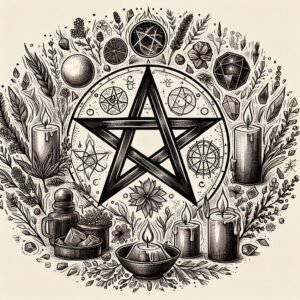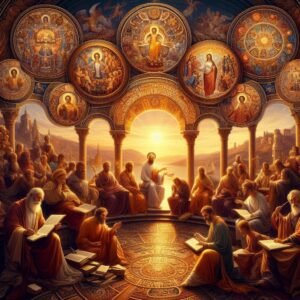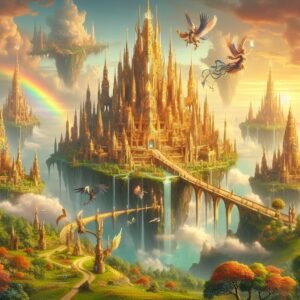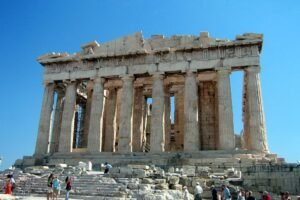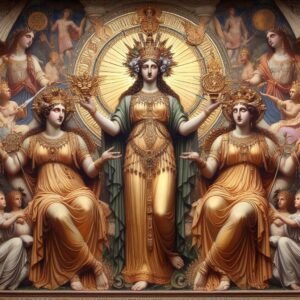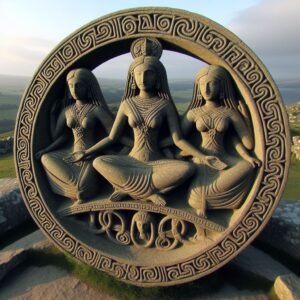
Continuity of custom in the context of changing religious and spiritual beliefs refers to the enduring elements of a culture’s traditions, practices, and values that persist even as new beliefs and practices emerge.
This concept is particularly relevant in societies where religious conversion or shifts in spiritual orientation occur, as it highlights the tension between preserving established customs and adapting to new ideologies.
For instance, a study on British converts to Islam suggests that rather than emphasizing either continuity or change, it is the dynamics between these two that reveal critical facets of religious identity. Similarly, the governance of religion in Sweden illustrates significant policy shifts while also engaging with the historical regulation of religious diversity, indicating a balance between tradition and transformation.
The University of Oxford discusses a ‘Continuity model’ that focuses on the translation, adoption, and adaptation of traditional values to modern realities, suggesting that despite secularization, traditional religious elements continue to influence contemporary life.
Moreover, the interplay between long-standing religious traditions and evolving societal values can create tensions that necessitate a balance to maintain religious relevance and community cohesion. Tradition and custom are essential in creating a sense of continuity and community within a faith, as they are meant to be transmitted across generations, thus fostering a unique bond among community members.
In essence, continuity of custom serves as a bridge between the past and the present, allowing a culture to retain its identity while also embracing change. It is a complex interplay of factors that shape how religious and spiritual beliefs are practised and understood in the face of societal evolution.
Customs with pagan origins
Many customs that are woven into the fabric of modern life have their origins in ancient pagan traditions, reflecting the enduring influence of these early spiritual practices. Halloween, for instance, is a direct descendant of the Celtic festival of Samhain, which marked the end of the harvest season and the beginning of winter. This time was believed to be when the veil between the living and the dead was thinnest, leading to traditions of honouring the deceased and warding off spirits. The days of the week, too, owe their names to pagan gods, with each day reflecting the influence of Norse, Germanic, or Roman deities. For example, Thursday derives from Thor’s Day, named after the Norse god of thunder.
Birthday celebrations, complete with candles on a cake, also have pagan roots. The lighting of candles was originally intended to protect the celebrant from evil spirits and to invite good fortune on their special day. Knocking on wood, a common superstition for ensuring good luck or warding off bad, can be traced back to the pagan belief that spirits resided within trees, and by knocking on wood, one could call upon these spirits for protection.
Weddings are replete with customs that have pagan origins. The practice of bridesmaids dressing similarly to the bride was once believed to confuse evil spirits or ill-wishers who might want to harm the bride on her wedding day. Even the tradition of Christmas, while now predominantly a Christian holiday, incorporates elements from pagan festivities such as the Roman Saturnalia and the Germanic Yule, which celebrated the winter solstice with feasts, gift-giving, and the burning of the Yule log.
The obsession with cats, often seen as mystical animals, dates back to Ancient Egypt, where cats were revered and associated with the goddess Bastet. This veneration of felines has persisted through the ages, with cats still often being regarded as creatures of mystery and magic. The concept of Mother Earth, a personification of nature and fertility, is another pagan concept that has been embraced by various cultures and religions throughout history, from the Greek Gaia to the Hindu Prithvi.
These customs and many others demonstrate the rich tapestry of human belief and the ways in which ancient practices have been adapted and absorbed into contemporary culture. They serve as a reminder of humanity’s deep connection to nature and the spiritual world, and how these connections have been honoured and celebrated throughout the ages. As society continues to evolve, it is likely that these ancient customs will continue to be reinterpreted and integrated into new forms of cultural expression, maintaining their relevance and significance in the modern world. Pagan traditions, therefore, are not relics of the past but living elements of the present, continually shaping and being shaped by the ongoing story of human civilization.
May Day
The celebration of May Day, observed on the first of May, is indeed a vibrant example of the continuity of ancient pagan fertility rites through modern festivities. Historically, May Day has its roots in various ancient cultures, with the Romans celebrating Floralia, dedicated to Flora, the goddess of flowers, and the Celts observing Beltane, a festival that marked the beginning of summer.
These celebrations were deeply intertwined with themes of fertility, renewal, and the blossoming of nature, elements that are still visible in contemporary May Day traditions. The customs of decorating a Maypole, dancing, and choosing a May Queen are reminiscent of the communal spirit and joy that characterized the ancient rites.
Even though the explicit connection to fertility might not be as pronounced today, the symbolic acts of planting and the crowning of a figure that represents youth and growth echo the ancient intentions of invoking a bountiful harvest and a prosperous season.
In England, the Green Man or Jack-in-the-Green, a figure adorned with foliage representing the spirit of nature, is a direct link to the reverence of natural vitality that was central to pagan beliefs. Moreover, the practice of Morris dancing, a traditional English folk dance, is often performed during May Day and is thought to have medieval, if not older, origins, further cementing the connection to past fertility observances.
Thus, while the modern celebration of May Day may not explicitly label itself as a fertility rite, the continuity of customs and symbolism from pagan times to the present day reflects a deep-seated human inclination to honour the cycles of nature and the life it sustains.
The evolution of May Day
May Day has evolved significantly over time, adapting to the cultural and social changes of each era while retaining its core essence of springtime festivity. Initially, May Day was intertwined with the Floralia, the Roman festival of flowers, and the Gaelic Beltane, both of which celebrated fertility and the renewal of life. As it transitioned into the Medieval period, May Day became a prominent festival in the British Isles, characterized by feasting, dancing, and various customs that symbolized the joy of spring and the promise of a fruitful season.
The evolution of May Day is marked by its ability to absorb and reflect the societal norms and practices of the times. For instance, during the medieval period, it was common for villages to select a May Queen to represent purity and the coming of spring, a tradition that continues in some form to this day. The maypole, another enduring symbol of May Day, has its origins in pagan rituals but was adopted by communities as a focal point for celebrations, with ribbons and dances that symbolize the intertwining of the community and the cycle of the seasons.
In the 16th century, May Day celebrations faced opposition and were even banned at times, leading to riots and unrest. The Puritans, in particular, frowned upon the festivities, associating them with pagan and heathenish customs. However, with the restoration of Charles II, May Day celebrations saw a revival, and the erection of a massive maypole in London’s Strand became a symbol of the return of traditional merriment.
Over the years, May Day has also been influenced by political and labor movements. The first of May was designated as International Workers’ Day in 1891, adding a new dimension to the date as a time for advocating workers’ rights and celebrating labor achievements. This aspect of May Day highlights the day’s flexibility in serving as a platform for various causes and celebrations.
In modern times, May Day continues to be a day of diverse celebrations, from traditional folk dances like Morris dancing to contemporary music festivals and community gatherings. The customs have been adapted to fit the local cultures and communities, with some places reviving ancient practices to foster a connection with their heritage. In this way, May Day serves as a living historical record, reflecting the changes in society while continuing to bring people together in a spirit of joy and community.
The continuity of May Day through the ages demonstrates the human desire to connect with nature, celebrate the cycles of life, and maintain a sense of community through shared traditions. As society progresses, May Day will likely continue to evolve, incorporating new meanings and practices while honouring the timeless themes of renewal and festivity that have always been at its heart. It stands as a testament to the enduring human spirit that seeks to commemorate the past while looking forward to the future.
Halloween
The origins of Halloween customs can be traced back over 2,000 years to the ancient Celtic festival of Samhain, celebrated on the night of October 31. This festival marked the end of the harvest season and the beginning of winter, a time associated with death due to the harsh conditions it brought. The Celts believed that during Samhain, the boundary between the worlds of the living and the dead became blurred, allowing the spirits of the deceased to return to Earth. To honour these spirits and avoid harm, the Celts would light bonfires, wear costumes made of animal heads and skins, and tell each other’s fortunes.
As time passed, the Roman Empire conquered Celtic lands and integrated two of their own festivals with Samhain: Feralia, a day to commemorate the dead, and a day to honour Pomona, the goddess of fruit and trees, which likely influenced the tradition of bobbing for apples on Halloween. With the spread of Christianity, the holiday was transformed into All Hallows’ Eve, a precursor to All Saints’ Day, which was established to honour saints and martyrs. The evening before All Saints’ Day, known as All Hallows’ Eve, retained many of the traditions of Samhain and eventually became known as Halloween.
The custom of wearing costumes and masks during Halloween also has its roots in both Celtic and Christian practices. The Celts donned costumes to disguise themselves from spirits, while Christians dressed up as saints, angels, and devils during All Hallows’ Eve celebrations. This practice evolved into the modern tradition of dressing in various costumes during Halloween.
Trick-or-treating, a quintessential Halloween activity, has a complex history. It is believed to have originated from the medieval practice of “souling,” where the poor would go door to door on Hallowmas (November 1), receiving food in return for prayers for the dead. This tradition was later taken up by children who would visit houses asking for gifts such as food, money, and ale. In Scotland and Ireland, there was a similar tradition called “guising,” where young people dressed in costumes and accepted offerings from households in exchange for a performance of some sort.
The carving of jack-o’-lanterns, another iconic Halloween tradition, stems from an Irish folktale about a man named Stingy Jack who tricked the devil and was doomed to roam the Earth with only a hollowed-out turnip to light his way. Immigrants from these regions brought the tradition to North America, where the native pumpkin, being larger and easier to carve, became the vegetable of choice for this practice.
In the United States, Halloween did not become a widely celebrated holiday until the 19th century, with the arrival of many Irish immigrants fleeing the potato famine. They brought with them their Halloween traditions, which blended with American harvest customs to create the modern Halloween celebration. The holiday continued to evolve, with the 20th century seeing the commercialization of Halloween and the establishment of community-based trick-or-treating as a safe way for children to celebrate the holiday.
Today, Halloween is a time for community gatherings, festive decorations, and, of course, trick-or-treating. The customs have adapted to the times, but the core elements—costumes, honouring the dead, and community celebration—remain deeply rooted in the ancient traditions of Samhain and the subsequent influences that shaped the holiday into what it is today.
Continuity of location
Locations of religious practice often evolve in their significance and the meanings they hold for communities, reflecting the dynamic nature of spirituality and cultural identity. These sites, ranging from ancient temples to modern churches, synagogues, mosques, and even natural landscapes, serve as focal points for communal worship, individual reflection, and the enactment of rituals that connect believers to their faith. Over time, as societies undergo religious, political, and cultural transformations, these locations can acquire new layers of meaning or even shift in their primary function.
For example, many ancient pagan sites were repurposed for Christian worship during the spread of Christianity throughout Europe. This was a strategic and symbolic act, overlaying new religious narratives onto old ones, and thus easing the transition between belief systems. The famous Pantheon in Rome, originally a temple dedicated to all the Roman gods, was converted into a Christian church, which helped to preserve the structure and integrate it into the fabric of Christian Rome. Similarly, the Hagia Sophia in Istanbul has served as a cathedral, a mosque, and now a museum, reflecting the changing religious and political landscapes of the region.
Natural locations, such as mountains, rivers, and groves, have also been sacred spaces for various religions throughout history. These places are often imbued with spiritual significance due to their perceived inherent power or beauty. For instance, Mount Fuji in Japan is sacred in both Shinto and Buddhist traditions, and the Ganges River in India is revered as a goddess in Hinduism. As beliefs evolve, these natural sites can become integrated into new religious frameworks or take on broader spiritual meanings that transcend a single faith tradition.
The evolution of religious practice locations is not just about changing religious meanings; it’s also about the social and cultural roles these places play. Often, religious sites become centres of community life, hosting markets, festivals, and social gatherings in addition to religious ceremonies. This multifaceted use of space reflects the central role of religion in daily life and the adaptability of religious practices to meet the needs of the community.
Furthermore, with the rise of secularism and the diversification of belief systems in many parts of the world, some religious sites have been transformed into secular spaces that serve various non-religious functions. For example, deconsecrated churches may be converted into concert halls, art galleries, or community centres, thus retaining their architectural and historical significance while serving the evolving needs of the community.
In the contemporary world, the meanings associated with locations of religious practice continue to evolve. Interfaith initiatives may lead to shared worship spaces, reflecting a desire for unity and cooperation among different religious groups. Environmental concerns have also influenced the way religious sites are viewed and used, with many faith communities emphasizing the stewardship of nature as a spiritual duty.
Subscribe to our post updates - Don't miss a thing!!


